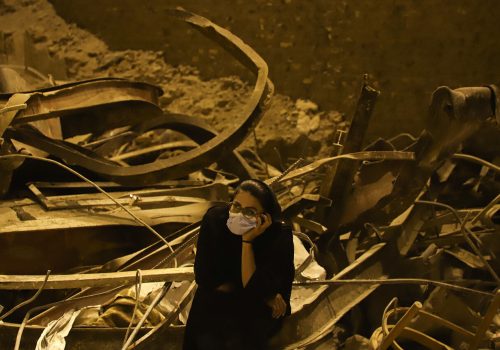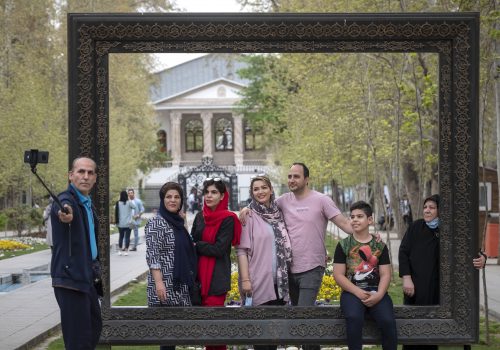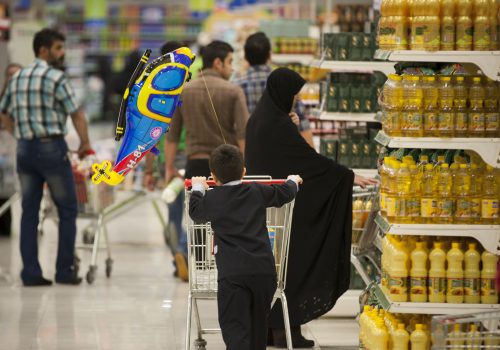The Internet has no place in Khamenei’s vision for Iran’s future
“Can you hear me? Mom, can you hear me?” I repeat frustratedly into my cell phone as our WhatsApp video call drops for the third time. When the call resumes, we speak of the Islamic Republic’s unwelcome presence in every Iranian’s life, which this time has manifested in the form of choppy Internet.
Over the past couple of weeks, authorities have been rolling out an “update” to its online censorship machine. This censorship behemoth has already cut Iranians’ access to almost all international news sources and every major social media platform—with the exception of Instagram—since they are seen as weapons of the enemy by Supreme Leader Ayatollah Ali Khamenei.
In a February speech, Khamenei warned about the enemies’ “hybrid warfare” against “Islam and the Islamic Republic” and that the “enemy”—presumably the United States—is trying to use “its media empire” and social media in an “onslaught to distort and destroy” the clerical establishment. The Supreme Leader called on authorities to launch “an enlightenment jihad” to take the war to the “enemy.”
This wasn’t the first or last time that the eighty-three-year-old leader described social media as a weapon. Over the years, Khamenei has consistently voiced his opposition to Iranians having “unbridled” access to the Internet. He has even gone as far as setting up the Supreme Council of Cyberspace, dominated by security agencies with no public oversight, to “regulate” online spaces and formulate Iran’s Internet policy.
Now, almost three decades after Iran connected to the Internet, Khamenei is rushing to impose the digital iron veil he has always dreamed of.
Upgrade to the censorship machine
In Iran, the number of Internet subscriptions surpasses the country’s eighty-three million population, since Iranians use multiple mobile and landline services to go online.
Although much of the nation is connected, the Islamic Republic has blocked access to a large portion of the Internet. Therefore, about 80 percent of Iranians rely on censorship circumvention tools, such as Virtual Private Networks (VPNs), and proxies for surfing the web.
Since mid-June, the Islamic Republic has been rolling out a new censorship machine, aggressively targeting VPNs via a method that scammers often use: Domain Name System (DNS) hijacking.
DNS works like a phone book—it allows users to reach what web domain they want. Hackers—in this case, the Islamic Republic—manipulate this phone book to deny users access to specific addresses or lead them to false destinations. Using this method, the state is disrupting access to popular services like Instagram—the only international social media platform not banned in the country.
The regime has also used the same method to manipulate people’s access to the Google search engine. When Iranians of all ages try to visit Google.com, their Internet traffic is redirected to http://forcesafesearch.google.com, which only shows age-appropriate content for children under 13.
Information and Communications Technology Minister Isa Zarepour has defended the move, saying that the government has only curtailed “easy access” to “immoral and violent” content in response to “repeated requests from families.”
At the same time, the state is employing intrusive measures like Deep Packet Inspection (DPI) to target encryption protocols. Encryption tools translate online communications into hard-to-decipher code to protect Iranians’ privacy. Since the technology blinds prying eyes, the clerical establishment has had a historical aversion to encryption and has criminalized it since 2009. In the new campaign, the establishment simply disrupts the delivery of encrypted packets. This has made WhatsApp video calls, like my own, choppy—though the Meta-owned messaging service isn’t blocked in Iran.
As if all these intrusive measures weren’t enough, the government of hardline President Ebrahim Raisi is expanding the online caste system that was initially introduced under his moderate predecessor, Hassan Rouhani. In this system, users are ranked based on their profession and proximity to power centers and are provided with different Internet access levels. The system has been in use since at least 2018 and employed by journalists close to the establishment, peddling disinformation on blocked social media platforms like Twitter, especially during social unrest.
New reign of terror
Whenever the Islamic Republic reaches an impasse in its foreign policy and faces an external threat, it immediately gears up its oppression machine at home.
With prospects of reviving the 2015 nuclear deal dimming, the economy crashing, ongoing food and water crises, simmering public frustration, and mounting civil unrest, the clerical establishment appears to be preparing for another reign of terror similar to the 1980s, when thousands of political prisoners were summarily executed.
In a June 28 speech, Khamenei alluded to that dark era. He told judicial authorities that power is a “divine blessing” that “must be used and not wasted,” and called on them not to be swayed by public opinion and to launch a merciless crackdown against all forms of “dissent” and online freedoms.
With executive power resting in the hands of President Raisi, who is accused of crimes against humanity, and the judiciary being controlled by Chief Gholamhossein Mohseni Ejei, who has the blood of journalists on his hands, officials don’t need much encouragement from the Supreme Leader to unleash brute force against the Iranian people.
Executions in Iran have more than doubled in the first half of 2022, with 251 people being hanged compared to the 117 in the first half of last year. Moroever, rights defenders have warned that, just like the past four decades, marginalized groups and ethnic minorities are taking the brunt of state oppression.
The state has responded to water and food protests with batons, water cannons, tear gas, bullets, and Internet shutdowns. At the same time, it has launched a hijab crackdown, trying to segregate workspaces and deprive women of basic services for not observing “Islamic” dress code, while violently arresting them for the same reason on the streets.
And, in the backdrop, the regime is deploying aggressive online censorship methods to tighten its grip on the flow of information.
Frustrated with the gloomy prospects, I sought advice, or maybe comfort, from a former political prisoner, who served four years in Islamic Republic prisons during the 1980s and survived execution by mere chance.
He pointed out that, throughout history, in the face of state brutality—whether at home or abroad—people didn’t rely on the Internet for overthrowing despotic laws and rulers.
Khosro Sayeh Isfahani is an advocate, journalist, and Internet researcher with years of experience working in Iran, including work related to the LGBTQI community.
Further reading
Wed, Jun 8, 2022
‘From Cinema Rex to Metropol,’ Iranians have had enough
IranSource By
On May 23, a ten-story commercial tower came crashing down on people’s heads in Abadan. With each body recovered from the ruins, public anger crescendoed, leading to ongoing street protests in multiple areas in Khuzestan province and beyond.
Thu, Jan 13, 2022
Iranians on #SocialMedia
Report By Holly Dagres
This report by the Future of Iran Initiative and Digital Forensic Research Lab (DFRLab) explores the social media habits of Iranian netizens and how the Islamic Republic is repressing the online space.
Thu, May 12, 2022
The Ebrahim Raisi government just jacked up food prices. Iranians are understandably angry.
IranSource By
The government of hardline President Ebrahim Raisi—who has been in office for less than a year—has opted to introduce coupons for almost everything from bread to Internet.
Image: Supreme Leader Ali Khamenei, in a June 28 speech, called on judicial authorities to launch a merciless crackdown against all forms of “dissent” and online freedoms. SOURCE: Khamnei.ir


